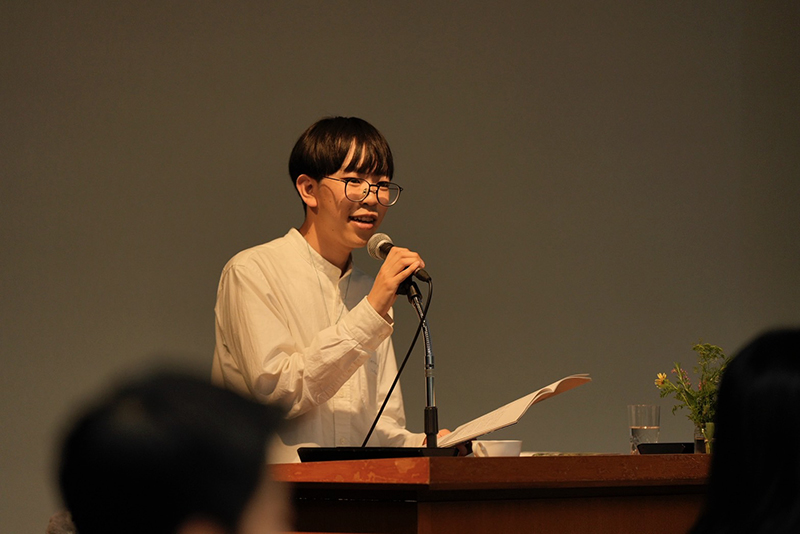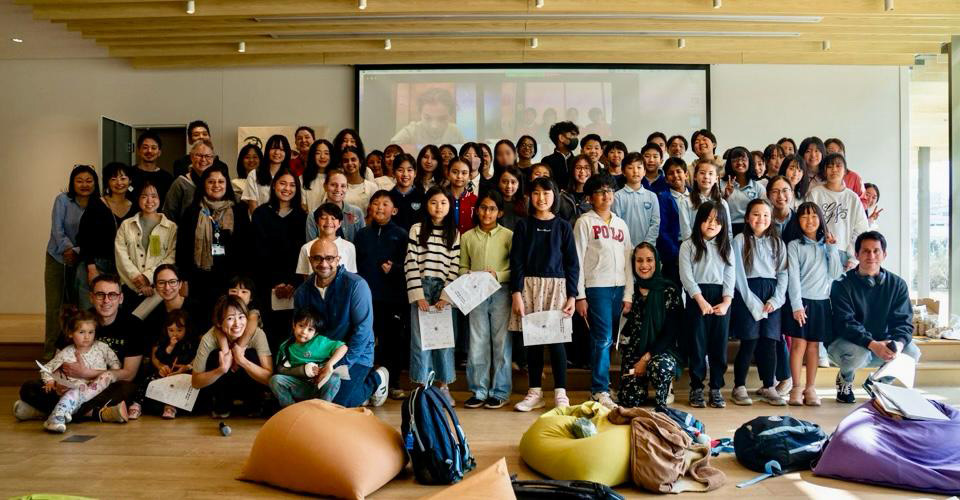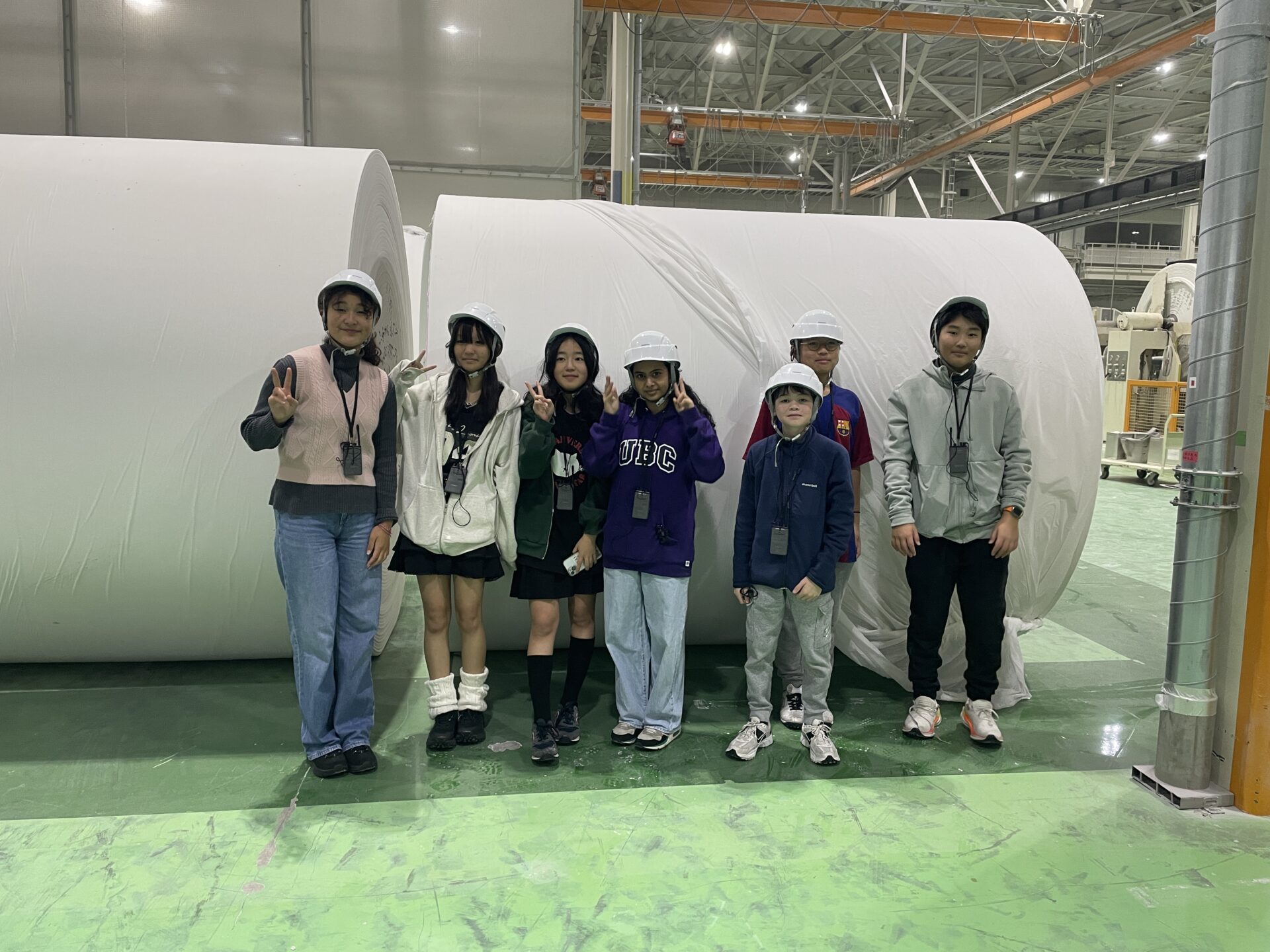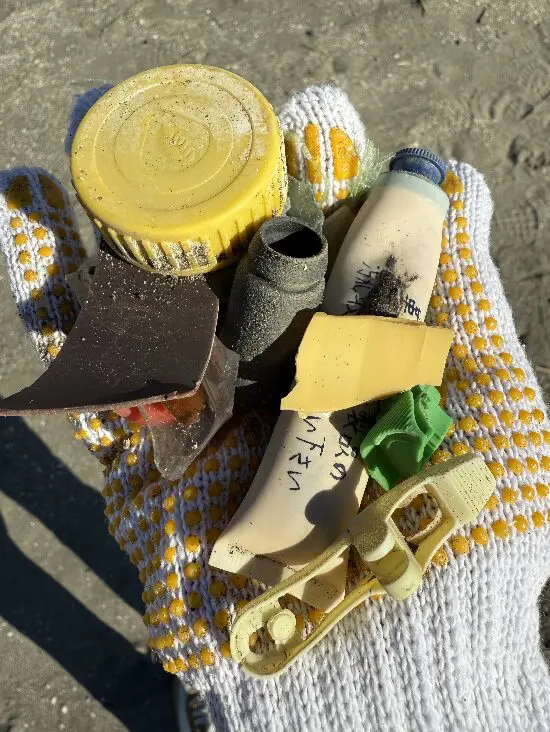ROOTS & SHOOTS
6月8日の世界海洋デー🐳資生堂グループやR&Sのメンバーと材木座海岸の和賀江島にて磯の観察会を行いました
🐚World Oceans Day on June 8th 🐳 Tidal pool observation with members of the Shiseido Group and R&S groups✨
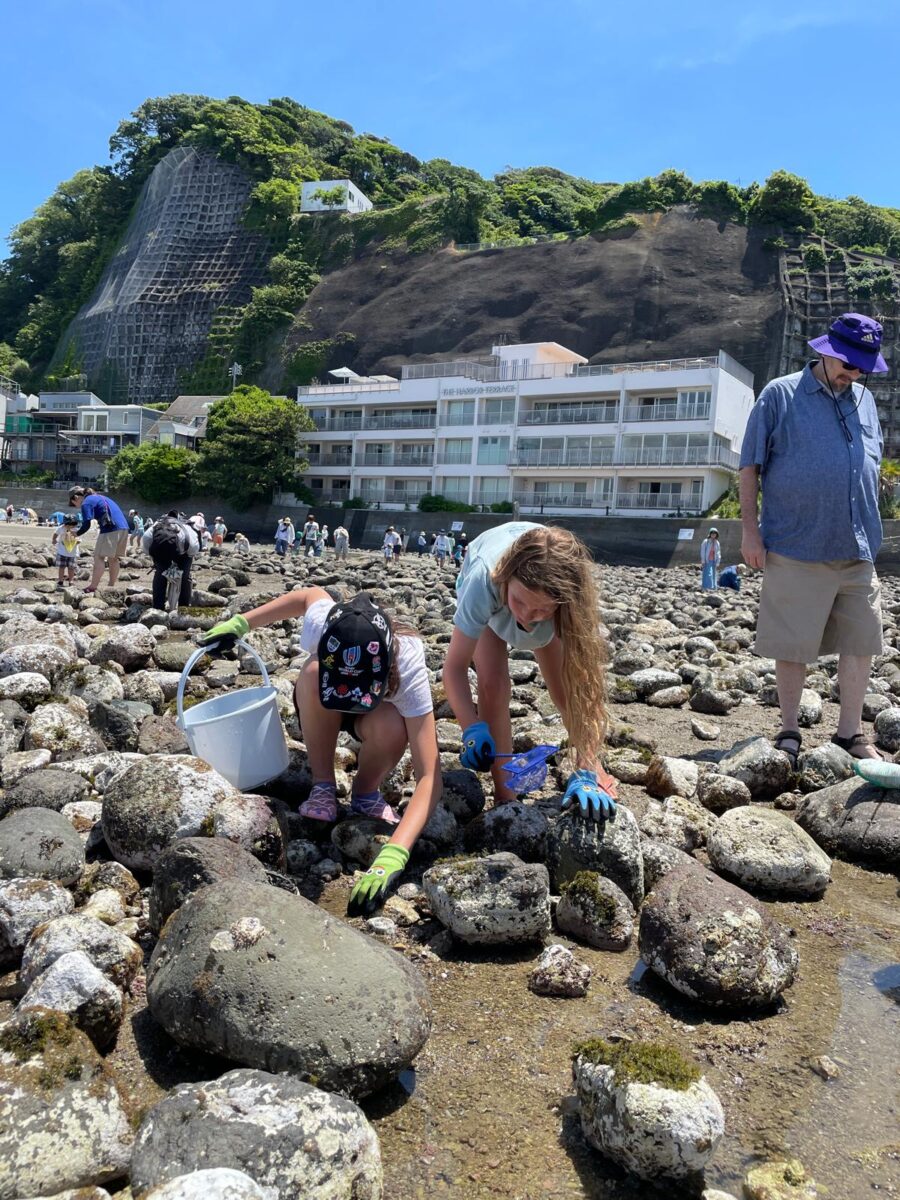
観察会にご参加いただいた皆様、ありがとうございました!
世界海洋デーにぴったりの、風の通る快晴の空の下、R&Sを企業としてご登録いただいた資生堂の社員や家族が70名、そしてR&Sグループからは46名が参加しました。
場所は、大潮前後の干潮の時だけ現れる鎌倉・材木座海岸”和賀江島”。実はここ、鎌倉時代に遠浅の鎌倉で寺社建築をするための材木などを運ぶ船のための日本最古の築港跡なんです。砂の上に積み重ねられた石は人工の磯となって、今では海の生き物の宝庫!季節ごとにたっぷり旬の海岸生物を観察できます。当日は、海の自然体験活動等を専門とするJGI-Japan理事長の小池潔が、楽しい海辺をしました。
また、観察会のあと、R&Sのメンバーは神奈川美化財団からゴミ袋を提供いただき、ゴミ拾いも実施しました。
🐚当日のお話のふりかえり🐚
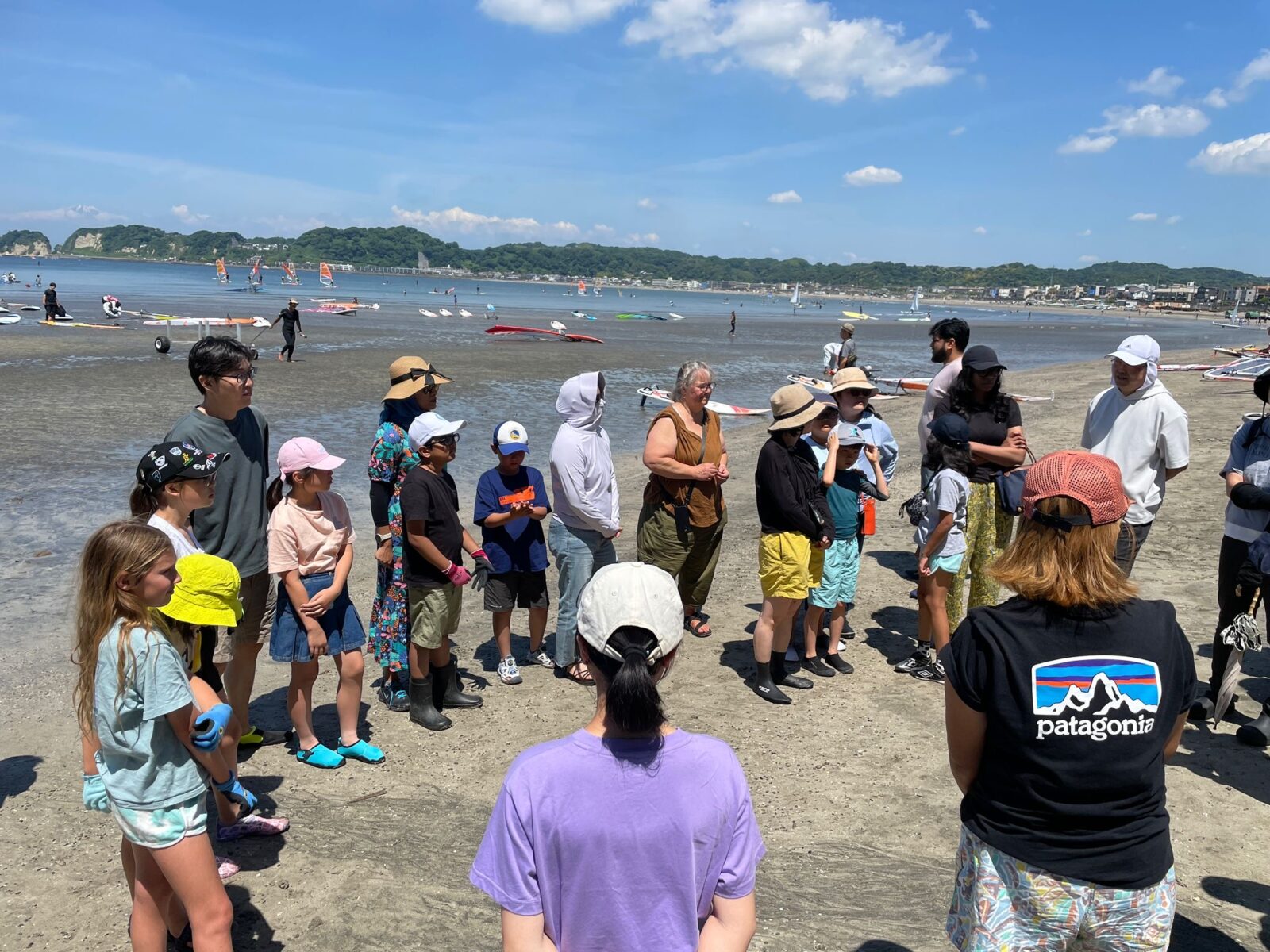
海岸線について
和賀江島では、日本で見られる海岸線のうち、サンゴ礁を除く海岸線が観察できます。
<日本で見られる海岸線>
①岩場、磯浜 ②砂地、砂浜 ③人工海岸、港湾、堤防など
多様な環境ほど、多くの生き物が観察できるので、上記の要素をコンパクトに満たした和賀江島は楽しいのです!
材木座海岸は遠浅(沖の方まで水深が浅い海)で大きな船は岸まで来られませんでした。しかし、鎌倉時代にたくさんの寺社を建てるための材木を大きな船で運ぶ必要があったため、玉石を敷き詰め、その上に船が停泊できる港を作りました。これが、日本最古の築港跡と言われ、大潮の干潮の時だけ全体が現れる和賀江島です。
元々の砂浜、積み上げられた玉石が作った人工の磯、これが多様な環境を作り出し、さらに潮の干満で海に沈んだり浮かび上がったりを繰り返し、季節によって北からも南から大きな海流に乗って様々な生き物が流れてきます。これらが和賀江島に『生物多様性』をもたらした秘密なのです。
余談ですが、例えば横浜市に海岸線は総計60Kmほどありますが、自然海岸はなんと合わせても数百メートルくらいです。あとは全て人工海岸なのです。
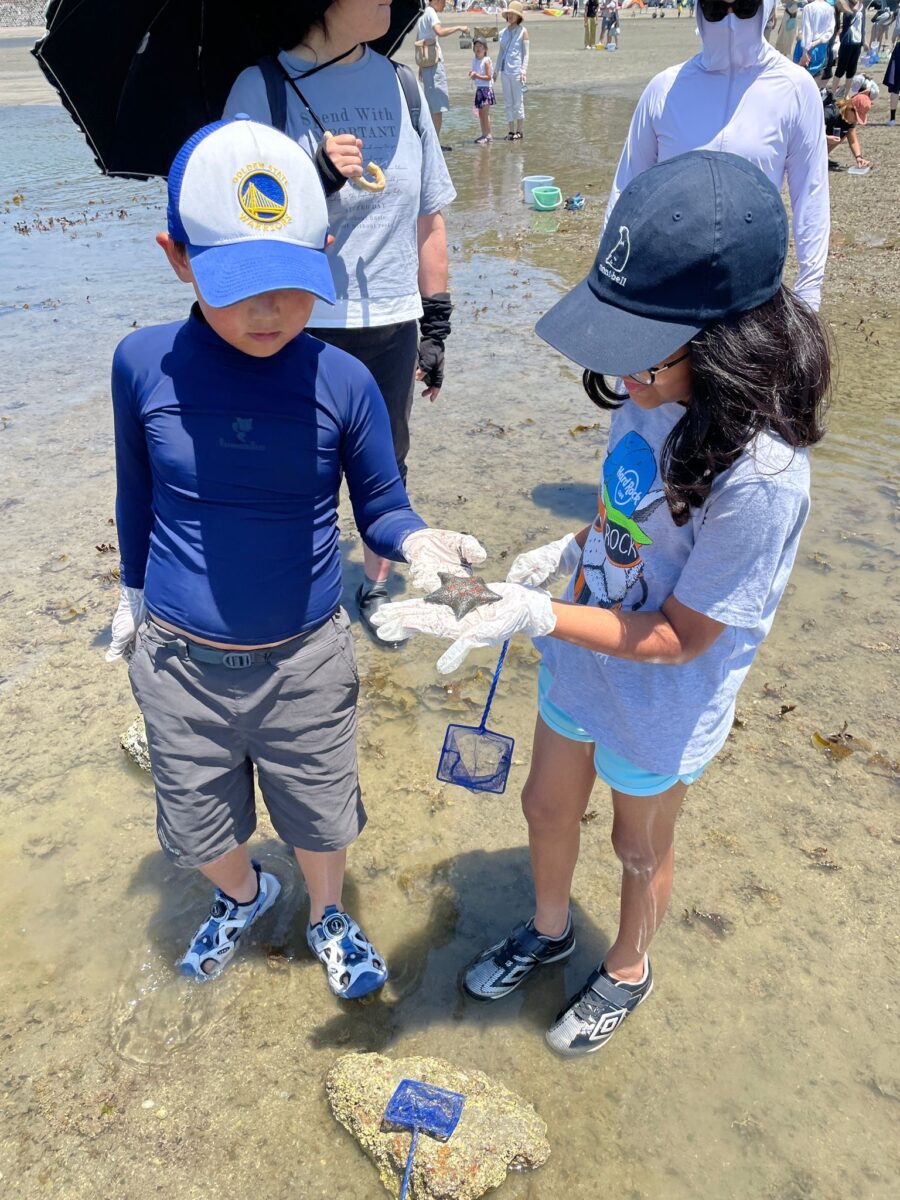
潮の干満(みちひき)について
地球・月・太陽の位置によって、海は水面の高さが変わります。満月や新月の前後は、地球・月・太陽が一列に並んでいるので、月が地球の海を引っ張る力が強く、干満の差が大きくなります。
太平洋側では、一番引いている時と一番満ちている時では、2m近く水面の高さが変わります。1日に2回ずつ、干潮と満潮を繰り返しています。この時の、満潮の時に一番陸まで海水が来るところと、干潮で一番潮が引いている時の海岸線の間を、潮間帯(ちょうかんたい)といいます。
一日2回ずつ、海になったり陸になったりするところで、この海の動きや波の動きをうまく使って、たくさんの生きものが生活しています。今回観察したのは、この潮間帯と言われるところです。
生き物観察は、大潮の干潮の時間を狙っていくと楽しめます。
干満の時刻は、インターネットなどで、潮時表+観察したい地名などで検索できます。
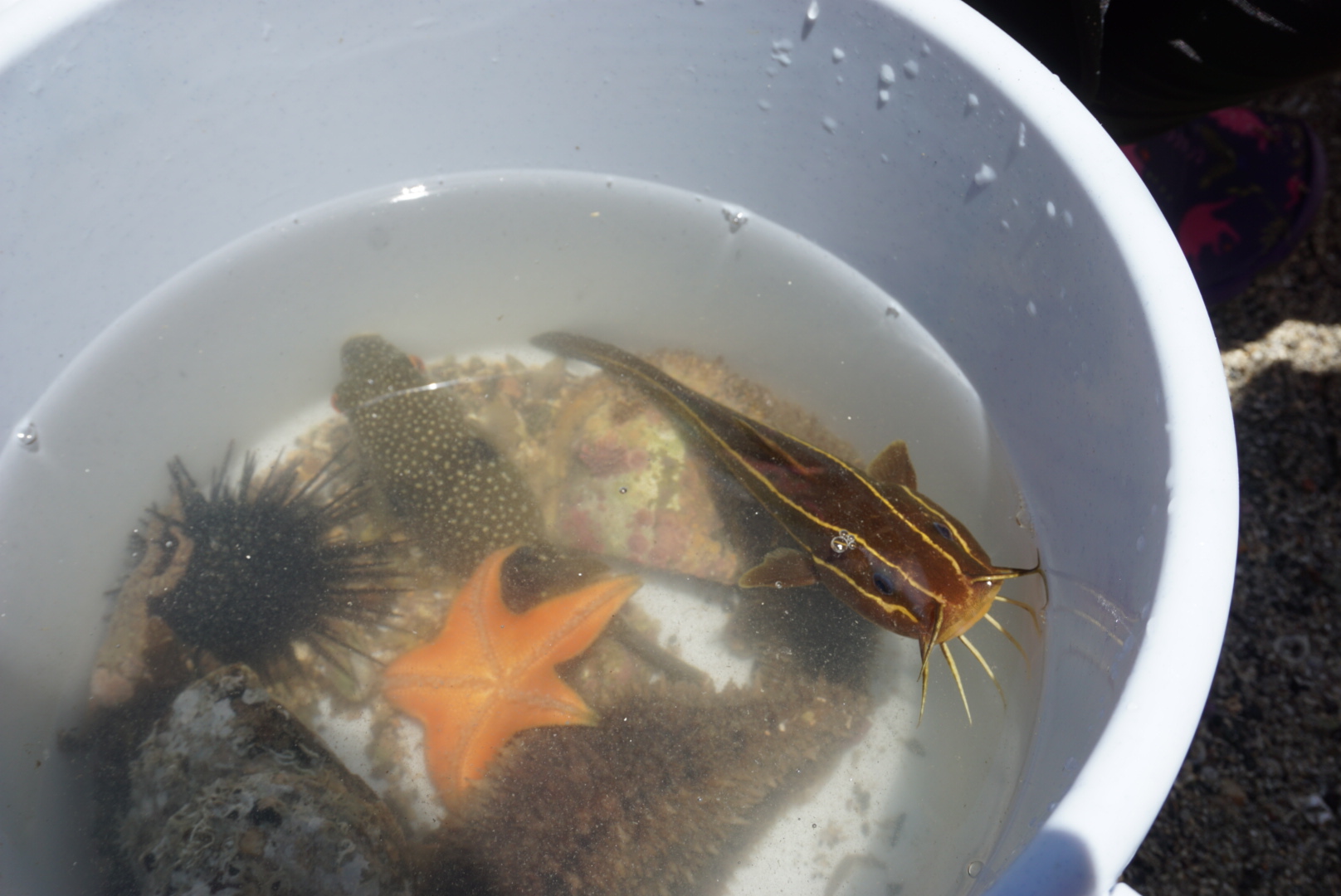
和賀江島をとりまく海の流れについて
南から、熱帯魚ごと流れてくる大きな黒潮と、北から、豊かなプランクトンなどと深いところに流れこんでくる親潮が、ちょうどぶつかるのが和賀江島のある相模湾です。相模湾は、少し沖に出ると、とても深くなっています。そのおかげで、季節ごとに、北からも南からも、さまざまな生きものが流れにのってやってきます。浅いところ、深いところなど、バラエティにとんだいろいろな環境があるので、自分に適したところを見つけた多くの種類の生きものがくらせるのです。
和賀江島でたくさんの生きものが見られるのは、以上の特色があるからです。
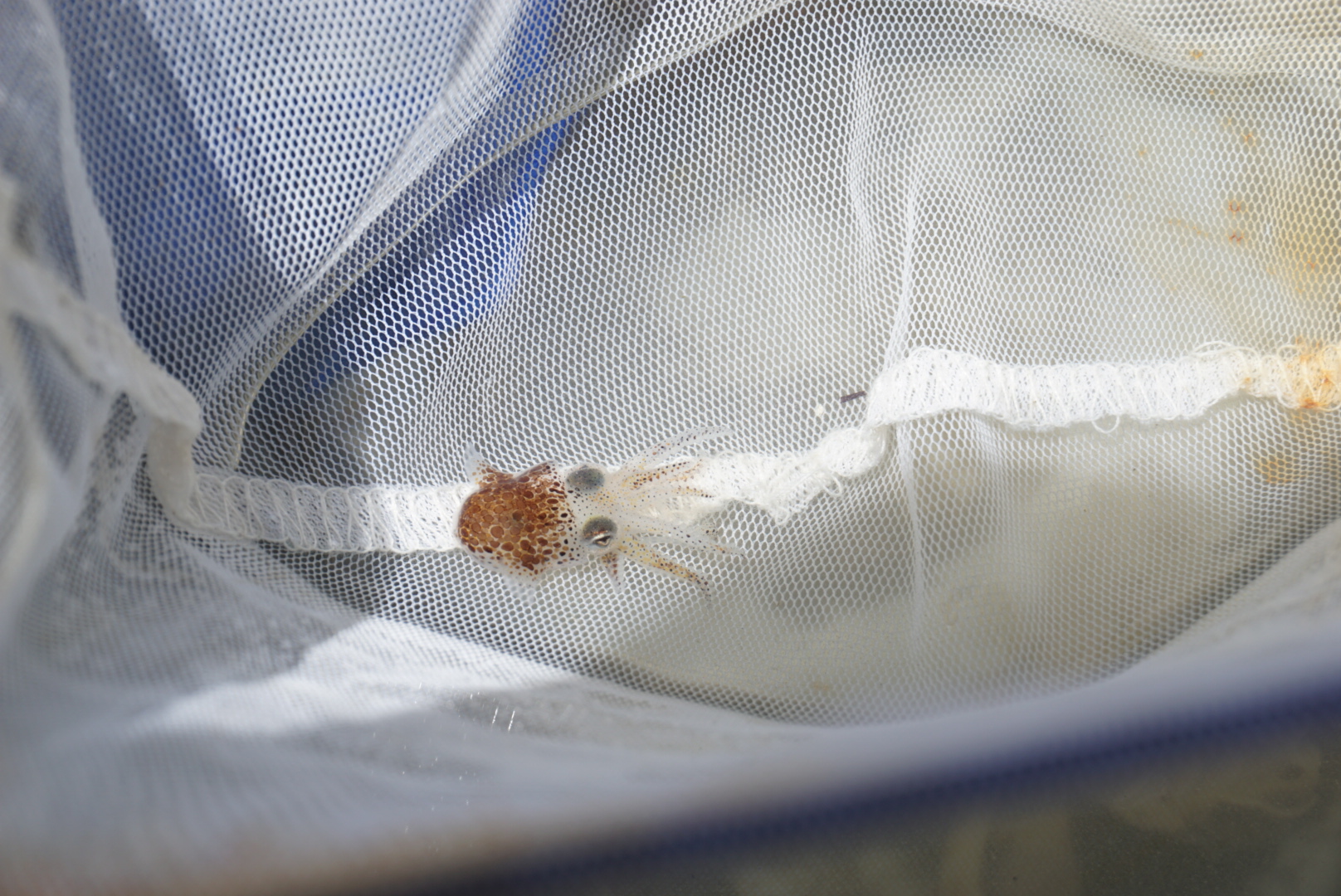
生き物たちの大循環について
例えばカニには、主に水面下にいるために一番下の足が平べったく、ボートのオールのようになって泳ぎ回るのに適しているものと、岩場などを歩き回るため、ハサミ以外のすべての足が爪のように尖っているものがいます。和賀江島のような場所は、時間によって岩場にもなれば水面下にもなるため、どちらの種類のカニも見られるのです。
ウニにも、ムラサキウニのようなトゲの長いもの、バフンウニのようにトゲの短いものがいますが、両方に適した環境があるため、どちらも見られます。
カジメやホンダワラのような海藻は、生活排水などに含まれるリンや窒素、そして二酸化炭素を吸収し、光合成で酸素を作ります。魚たちを含む動物は、それらの酸素のおかげで呼吸ができます。
カジメなどの葉の部分はアイゴなどの餌になり、漂うホンダワラなどは小魚の隠れ家になります。やがて磯や浜に打ち上がるとフナムシやハマトビムシなど、海のおそうじ屋さんがいて、寄ってたかって食べてしまいます。その糞が引き潮に乗って浜から海に流れて、小さなプランクトンの養分になります。それを大きなプランクトンが食べ、それを小魚が食べ、またそれを大きな魚が食べ、さらにそれをイルカなど大きな海の哺乳類(ほにゅうるい)や海鳥が食べます。大きなイルカなどが生を終えると、それを小さな生き物が餌とし、分解された体はプランクトンを育てます。こうして大きな輪が回るようにいろいろな生きものが関係しあって、今の海辺の姿があります。今、問題となっている磯焼け(水中にたくさん森のように海藻が生い茂っていたのに、海藻がなくなり岩だけの禿げ山のようになってしまった状態のこと)は、何らかの影響でカジメなどがなくなり、生態系の輪が途切れてしまう原因となります。
そして、その輪の中に私たち人間もいるのです。
いつまでも和賀江島が豊かな海であるよう、観察するときは、そっと覗かせてもらう気持ちで、なるべくその場を荒らさないよう配慮し、これからも観察のために採った生き物たちは、また海に戻したいと思います。
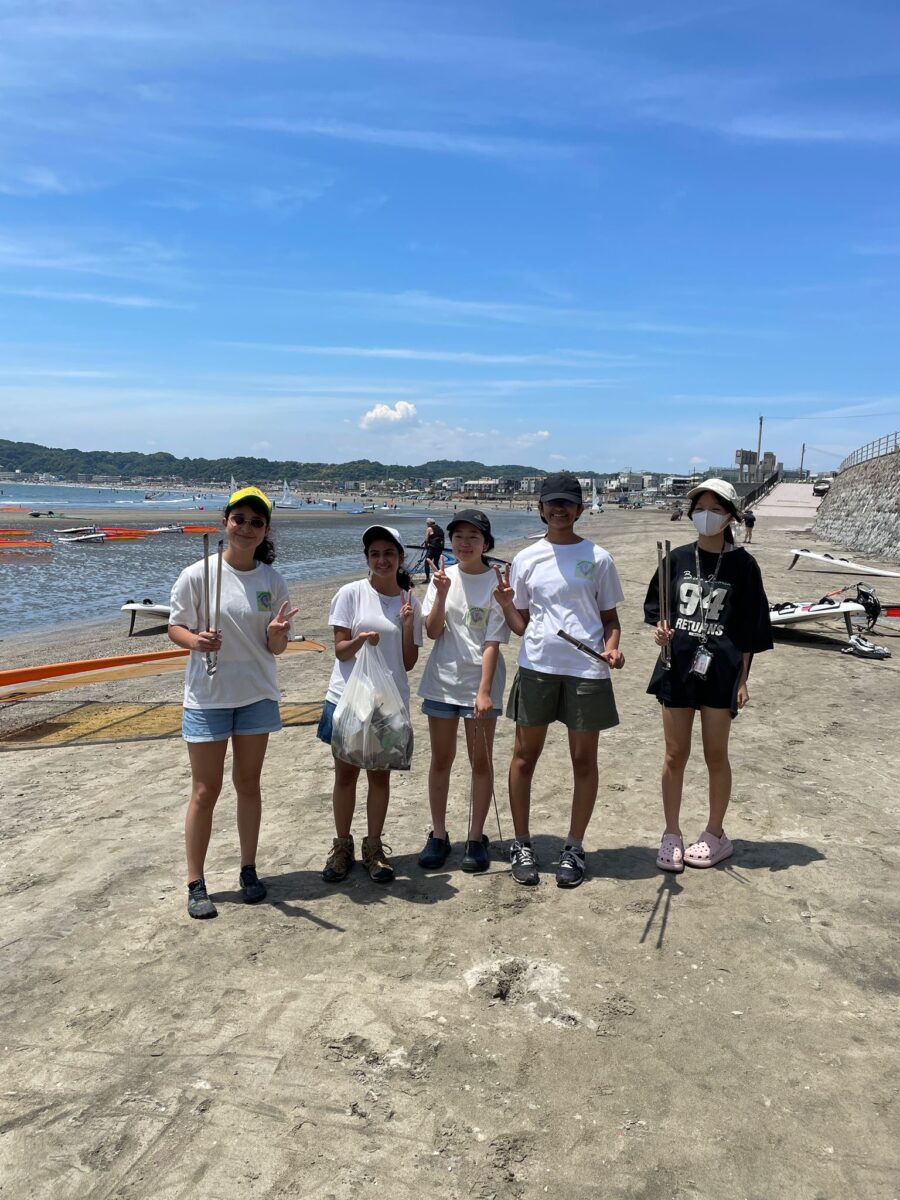
ビーチクリーンについて
海岸美化についてはじめの一歩。
「はじめは、ゴミだけを拾おうと思なくていい。どんなものがあるかよく観てきてほしい。素敵なものもたくさん打ち上がっているし、嫌だなと思うものもあるでしょう。まず気になるものを浜で分けてみよう!海から来たもの、川などを通じて陸から来たもの、自然のもの、人工物など。素敵なものはビーチコーミングのお楽しみとして思い出のコレクションに!嫌だなと思ったものは、何で嫌だと思ったのかその理由を考えてみよう。そして後で説明を聴いて、回収すべきものを袋に入れて、今後の海岸清掃の参考にして下さい。」
直に触ると危険なものも落ちているので、トングなどを使いましょう。
<海岸清掃の参考情報>
神奈川県内で海岸清掃をしたいと思ったら、「かながわ海岸美化財団」というところがいろいろ案内してくれます。
ゴミ回収用の袋の支給、集めたゴミの回収をしてくれます。相談してみてください。
公益財団法人 かながわ海岸美化財団
HP:https://www.bikazaidan.or.jp
住所:253-0033 神奈川県茅ケ崎市汐見台1-7
連絡先TEL:0467-87-5379
e-mail:info@bikazaidan.or.jp
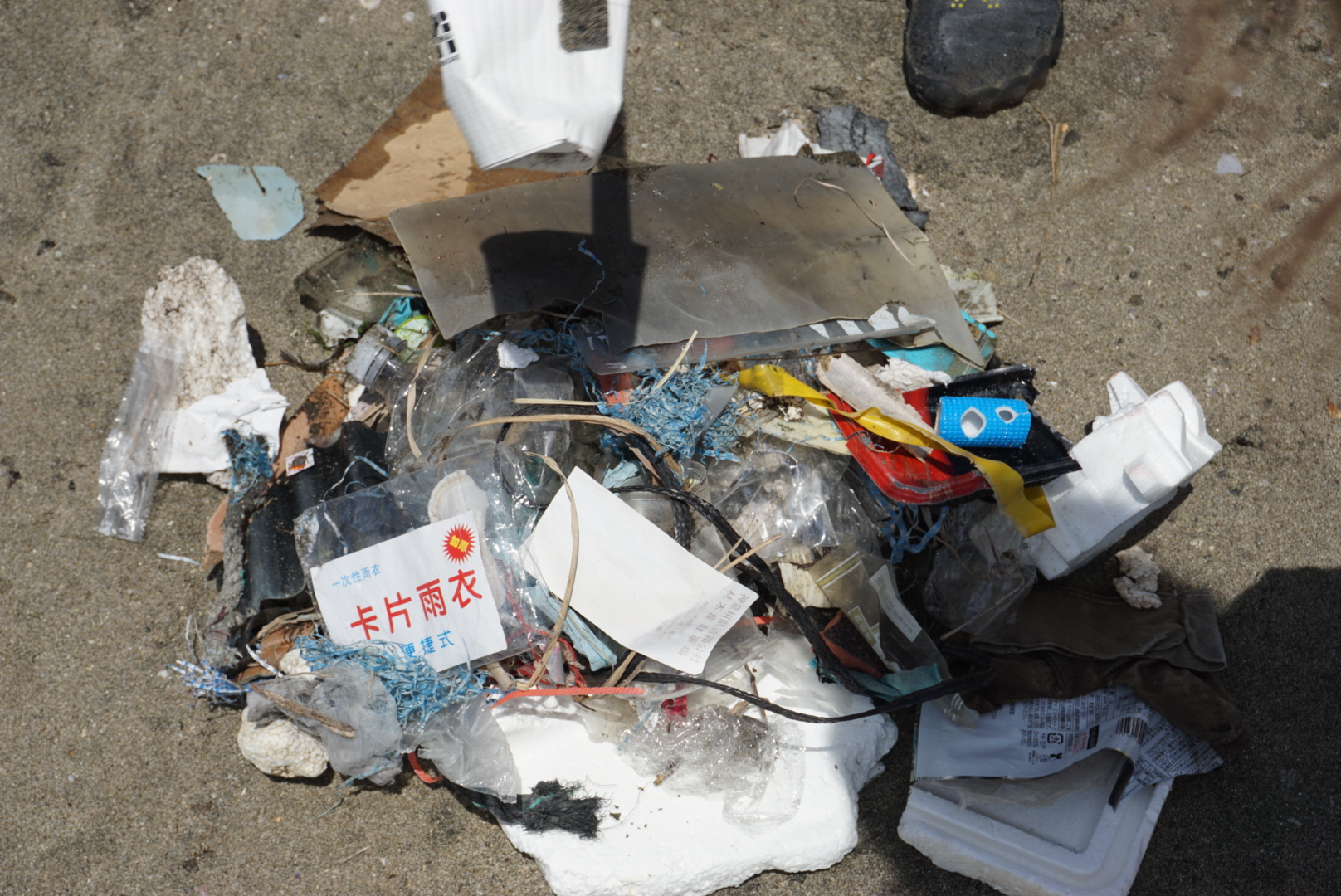
この辺りに生息する生き物たち。何匹見つけたかな?
【魚のなかま】
アゴハゼ:forktongue goby (Chaenogobius annularis)
ボラ幼魚:young Japanese mullet
ナベカ:stickleback (any fish of family Gasterosteidae)
キタマクラ:Eptatretus okinoseanus (species of hagfish found in Japan and Taiwan)
ダイナンギンポ:tidepool gunnel sp.
ノコギリハギ:sawfish
【ウニ・ヒトデのなかま】
ムラサキウニ:purple sea urchin (Heterocentrotus mammillatus)
バフンウニ:Buffoon sea urchin、馬糞:horse dung
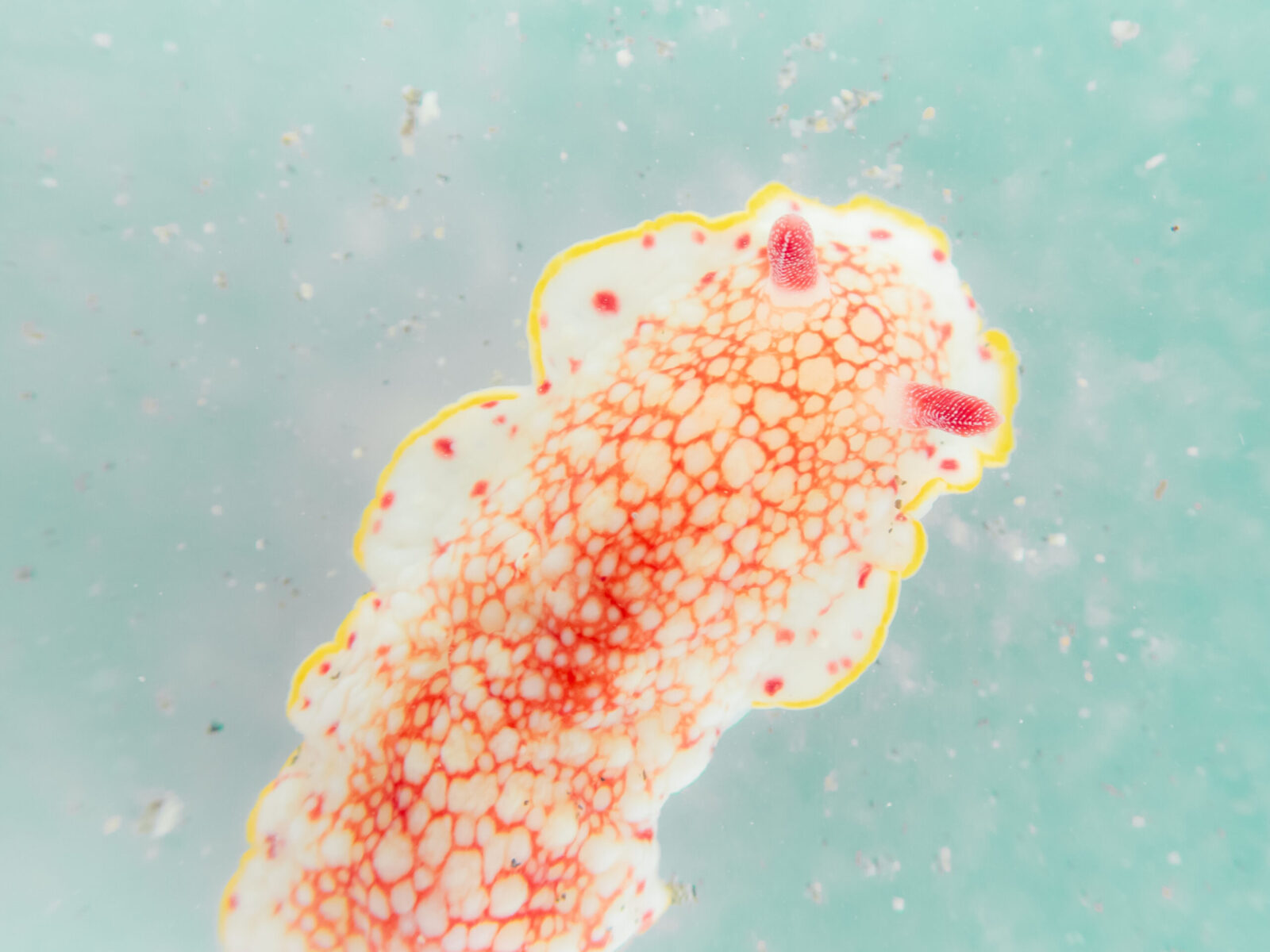
サラサウミウシ。スタッフの山本撮影。
【エビ・カニのなかま】
イソスジエビ:blunt slipper lobster (species of shovel-nosed lobster, Scyllarides squammosus)
テッポウエビ:shrimp
ホンヤドカリ(ツメの先が白い):hermit crab
ベニホンヤドカリ:hermit crab
イソクズガニ、イシガニ、ツノガニ、イソガニ、
ヒライソガニ:Asian shore crab (Hemigrapsus sanguineus)
フナムシ:wharf roach (species of isopod closely related to the sea slater; Ligia exotica)
ハマトビムシ:beach flea (any amphipod of family Talitridae)
【貝・イカ・タコのなかま】
アコヤガイ:Marten’s pearl oyster (Pinctada fucata martensii)
クロチョウガイ:black-lip pearl oyster (Pinctada margaritifera)
カモメガイ(石に穴を開けて住んでいた貝)
ケガキやイワガキ:Oyster
アメフラシ:sea hare (esp. species Aplysia kurodai)
ゴカイなどの環形動物:annelid
クモヒトデ:brittle star (any starfish-like echinoderm of the order Ophiuroidea)
イトマキヒトデ:crown-of-thorns starfish (Acanthaster planci)
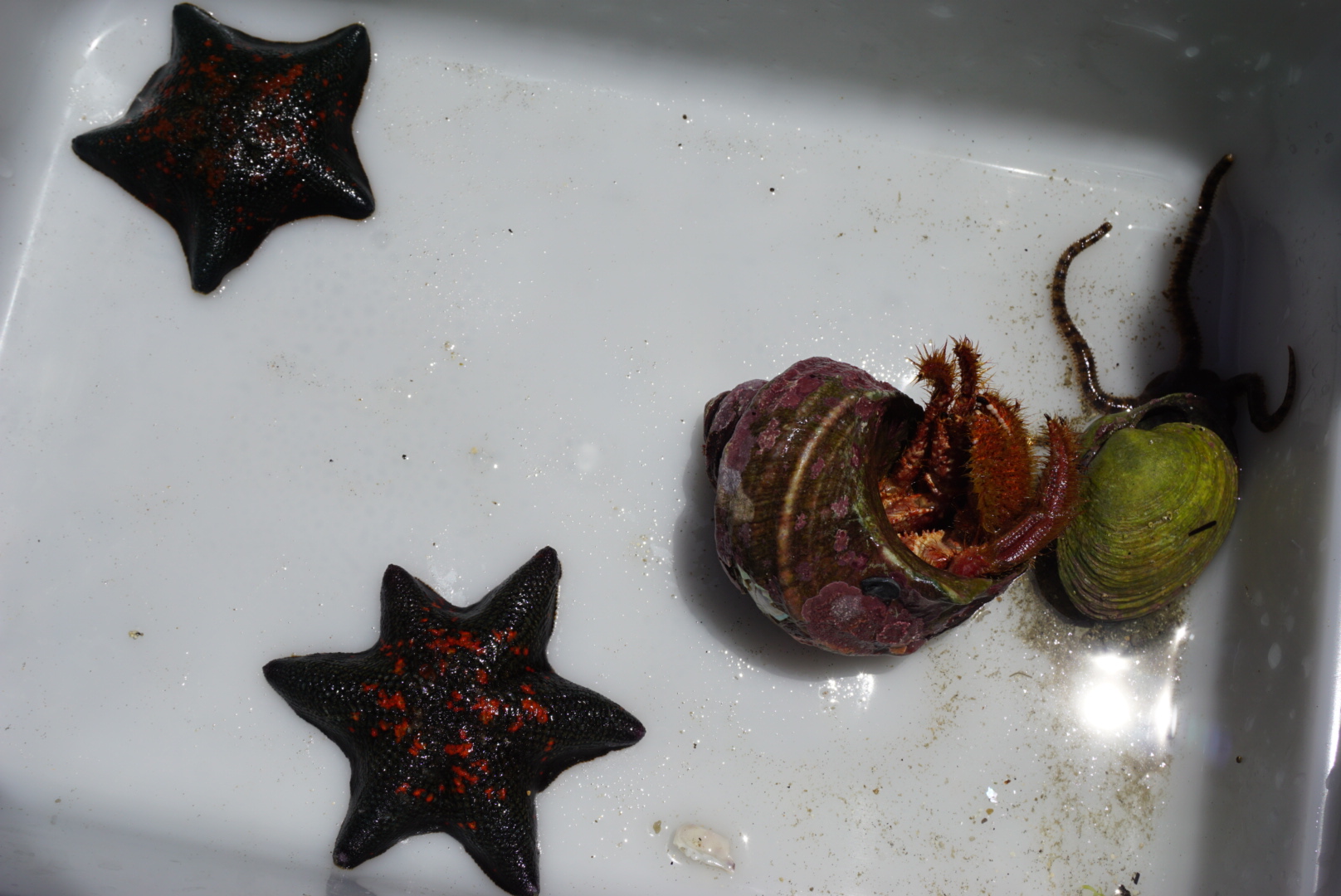
【海藻・海草のなかま】
アマモ(海草):Japanese eelgrass
ホンダワラ:Sargassum fulvellum (species of edible brown alga)
カジメ:Ecklonia cava (species of brown alga)
緑藻:green algae 褐藻:Brown algae 紅藻:Red algae
など
【観察に注意が必要な危険な生き物】
クラゲ類:jellyfish
アンドンクラゲ:Andon jellyfish
カツオのエボシ:Portuguese man-of-war (Physalia physalis)
ハオコゼ:Hypodytes rubripinnis (species of waspfish)
ゴンズイ:striped eel catfish (Plotosus lineatus)
ガンガゼ(ウニの仲間):Sea urchin
フジツボ:acorn barnacle (Balanomorpha spp.)
サメ:shark (esp. the Japanese shark, Carcharhinus leucas)
ヒョウモンダコ:blue-ringed octopus (esp. one species, the blue-lined octopus, Hapalochlaena fasciata)
ここには100種類以上の海岸生物が生息すると言われています!ウミウシなど珍しい生き物を見つけた人もいたのでは?
Thank you to everyone who participated in the beach observation event!
With nice breeze and sunshine, it was perfect condition to celebrate the World Oceans Day. Approximately 70 Shiseido employees and their families, who have registered R&S as a company, and 46 members from the R&S group joined the amazing day.
The location was Wagaejima on Zaimokuza Beach in Kamakura, which appears only during low tide around the spring tide. Wagaejima is actually Japan’s oldest constructed port, built in the Kamakura period for ships carrying timber and other materials for temple and shrine construction in Kamakura’s shallow waters. The stones piled on the sand create an artificial rocky shore that is now a treasure trove of marine life, so you can observe a variety of seasonal coastal creatures. On the day of the event, JGI-Japan President Kiyoshi Koike, who specializes in marine nature activities, led the enjoyable seaside exploration.
R&S members also done beach cleanup. They brought their own tongs and used the garbage bags provided by the Kanagawa Bika Zaidan.
🐚 Throwback & Highlights of the Day 🐚
About the Coastline
At Wagaejima, you can observe the coastline types seen in Japan, excluding coral reefs.
<Coastline Types in Japan>
① Rocky and tidal shore ② Sandy beach ③ Artificial coastline, port, breakwater, etc.
Diverse environments allow for the observation of many creatures, making Wagaejima, which compactly fulfills these elements, enjoyable!
Zaimokuza Beach has a shallow gradient, making it inaccessible to large ships. However, during the Kamakura period, it was necessary to transport large timbers by ship for the construction of many temples and shrines. Thus, stones were laid down to create a port where ships could dock, forming Wagaejima, which appears only during low tide around the spring tide.
The original sandy beach and the artificially created rocky shore by the piled stones create a diverse environment. The rising and falling tides submerge and expose the area, and various creatures ride the major ocean currents from both the north and the south to this place depending on the season. These factors have brought biodiversity to Wagaejima.
As an aside, for example, Yokohama City has a total of about 60 km of coastline, but only a few hundred meters of natural coastline. The rest is all artificial.
About the Tides
The height of the sea level changes depending on the positions of the Earth, the Moon, and the Sun. Around the full moon and new moon, the Earth, Moon, and Sun align, making the Moon’s pull on Earth’s oceans stronger and increasing the difference between high and low tides.
On the Pacific side, the difference between the highest and lowest tides can be nearly 2 meters. There are two high tides and two low tides each day. The intertidal zone is the area between the highest high tide mark and the lowest low tide mark. Many creatures live in this intertidal zone, making use of the movement of the sea and waves. We observed this intertidal zone during our event.
You can enjoy observing marine life by targeting the time of low tide around the spring tide. Tide tables can be found online by searching for “tide table + the name of the location you want to observe.”
About the Ocean Currents Surrounding Wagaejima
The Kuroshio Current, which brings tropical fish from the south, and the Oyashio Current, rich in plankton from the north, converge in Sagami Bay, where Wagaejima is located. Sagami Bay becomes very deep a little offshore, allowing various creatures to ride the currents to this place depending on the season. The diversity of environments, including shallow and deep areas, allows many species to find suitable habitats. The reason why we can see so many creatures at Wagaejima is due to these features.
About the Large Circulation of Marine Life
For example, crabs adapted for swimming with flat, paddle-like legs and those adapted for walking on rocks with claw-like legs can both be found at Wagaejima, which changes between rocky and submerged environments.
Sea urchins like the long-spined purple sea urchin and the short-spined buffoon sea urchin can both be found, as the environment suits both.
Seaweeds like kajime and hondawara absorb nitrogen, phosphorus, and carbon dioxide from wastewater and photosynthesize to produce oxygen, which animals like fish need for respiration.
The leaves of kajime become food for fish like rabbitfish, and floating hondawara provides hiding places for small fish. When seaweeds wash ashore, scavengers like sandhoppers and beach fleas eat them, and their waste becomes nutrients for plankton. Larger plankton eat the smaller ones, small fish eat the plankton, larger fish eat the small fish, and eventually, marine mammals like dolphins and seabirds eat the larger fish. When these large animals die, smaller creatures feed on them, and their decomposed bodies nurture plankton, continuing the cycle. This large circle of life, in which we humans also participate, maintains the current state of the shoreline.
To ensure that Wagaejima remains a rich marine environment, we should observe creatures gently and avoid disturbing their habitat, returning the creatures we collect to the sea.
About Beach Cleaning
Beach cleaning are the first step in beach beautification. At first, you don’t have to think about just picking up trash. Take a good look at what’s there. You’ll find many wonderful things washed ashore, as well as things you don’t like. First, try separating what you find on the beach. Things from the sea, things from land via rivers, natural objects, artificial objects. Enjoy beachcombing by collecting wonderful things as memories! Think about why you didn’t like certain things. Then, after listening to the explanation, put the items that should be collected in a bag, and use this as a reference for future beach cleanups. Use tongs or other tools, as some items can be dangerous to touch directly.
<Information on Beach Cleaning>
If you want to clean a beach in Kanagawa Prefecture, the Kanagawa Coastal Beautification Foundation can guide you. They provide garbage bags and collect the gathered trash. Consult with them.
Kanagawa Coastal Beautification Foundation
HP: https://www.bikazaidan.or.jp
Address: 1-7 Shiomidai, Chigasaki City, Kanagawa 253-0033
TEL: 0467-87-5379
e-mail: info@bikazaidan.or.jp
How Mary Creatures Did You Find? Marine Creatures in This Area
【Fish】
Forktongue goby (Chaenogobius annularis)
Young Japanese mullet
Stickleback (any fish of family Gasterosteidae)
Eptatretus okinoseanus (species of hagfish found in Japan and Taiwan)
Tidepool gunnel sp. Sawfish
【Sea Urchins and Starfish】
Purple sea urchin (Heterocentrotus mammillatus)
Buffoon sea urchin
【Shrimp and Crabs】
Blunt slipper lobster (species of shovel-nosed lobster, Scyllarides squammosus)
Shrimp
Hermit crab (with white-tipped claws)
Hermit crab Asian shore crab (Hemigrapsus sanguineus)
Various other crabs
Wharf roach (species of isopod closely related to the sea slater; Ligia exotica)
Beach flea (any amphipod of family Talitridae)
【Shellfish, Squid, and Octopus】
Marten’s pearl oyster (Pinctada fucata martensii)
Black-lip pearl oyster (Pinctada margaritifera)
Various other shellfish
Sea hare (esp. species Aplysia kurodai)
Annelid worms
Brittle star (any starfish-like echinoderm of the order Ophiuroidea)
Crown-of-thorns starfish (Acanthaster planci)
【Seaweeds and Seagrasses】
Japanese eelgrass
Sargassum fulvellum (species of edible brown alga)
Ecklonia cava (species of brown alga)
Green algae
Brown algae
Red algae, etc.
【Dangerous Creatures to Observe Carefully】
Andon jellyfish
Jellyfish Portuguese man-of-war (Physalia physalis)
Hypodytes rubripinnis (species of waspfish)
Striped eel catfish (Plotosus lineatus)
Sea urchin
Acorn barnacle (Balanomorpha spp.)
Shark (esp. the Japanese shark, Carcharhinus leucas)
Blue-ringed octopus (esp. one species, the blue-lined octopus, Hapalochlaena fasciata)
AND MORE!!! It is said that more than 100 species of shore creatures live here! Some of you may have found nudibranchs and other unusual creatures.
